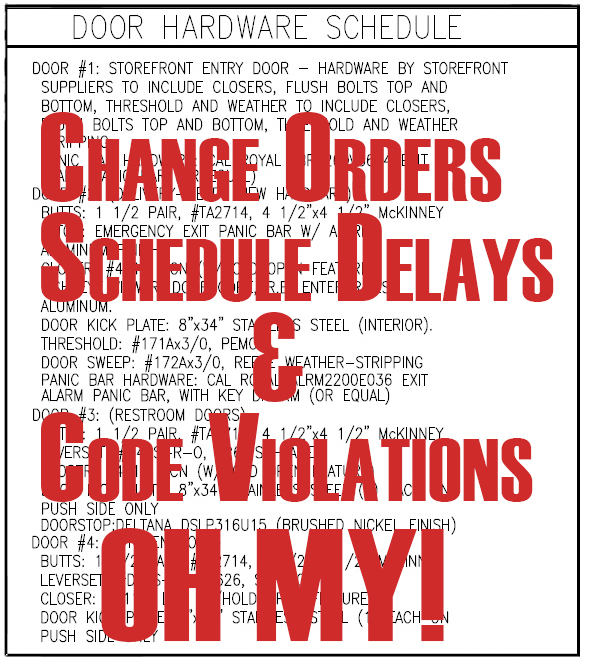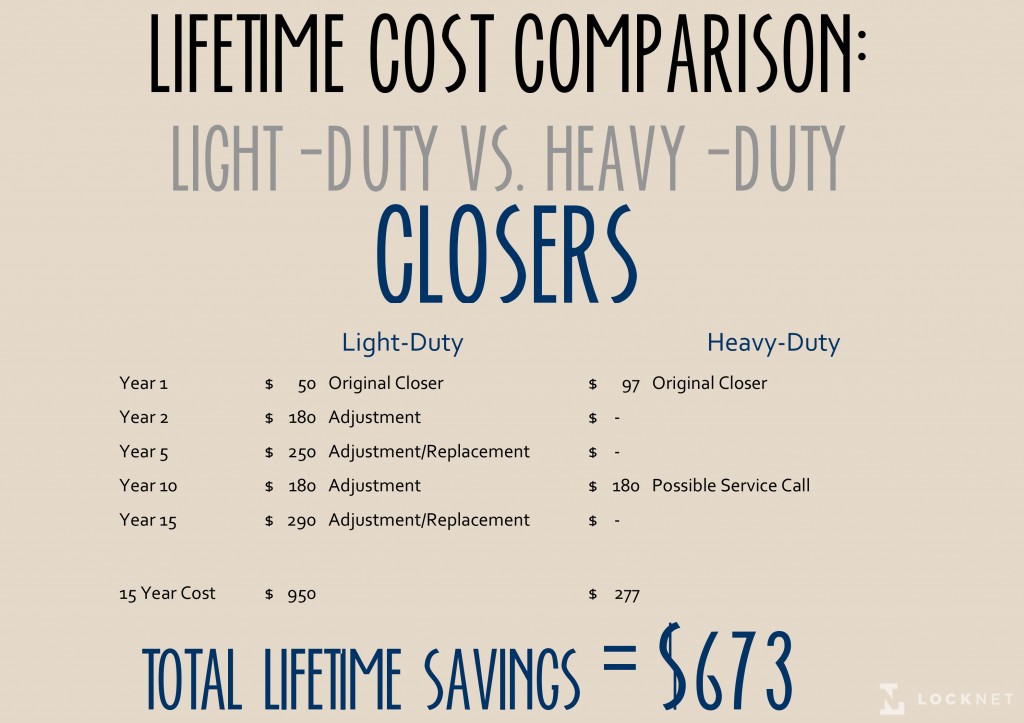What are you risking by not verifying the integrity of your openings?
 In a recent article I discussed the complications that arise when architectural plans contain an incomplete door and hardware schedule, but what happens when the specification is completed incorrectly? Although not as easily recognizable, an incorrect hardware schedule can have ramifications just as damaging as their incomplete counterparts. Incorrectly specified parts run a high risk of violating local codes, breaking, and malfunctioning – all of which will cost your organization money for years to come.
In a recent article I discussed the complications that arise when architectural plans contain an incomplete door and hardware schedule, but what happens when the specification is completed incorrectly? Although not as easily recognizable, an incorrect hardware schedule can have ramifications just as damaging as their incomplete counterparts. Incorrectly specified parts run a high risk of violating local codes, breaking, and malfunctioning – all of which will cost your organization money for years to come.
Incorrect hardware schedules can be caused by a variety of issues ranging from software malfunctions to an uneducated or misinformed specifier. Specification consultation provides a second “set of eyes” to correct flaws before they affect your facilities.
Architectural Hardware Consultants (AHCs) spend years gaining their certifications, so it’s safe to assume there are numerous variables that must be evaluated for each product. The specific hardware functions needed will depend on a number of things, here are a few of the top items our AHCs look at when reviewing specifications:
- Facility’s traffic volume
- Local code
- Opening’s location and usage purposes
When these variables are assessed, AHCs will ensure that the following criteria are addressed for each opening.
Hardware Schedule – Heavy-Duty
If the door in question is located within a high-use commercial building, it should be accompanied by heavy-duty hardware. This is especially important on high-use doors; think public restrooms, entry doors, back of house doors, and offices. There are a number of ‘grades’ applied to hardware – grades 1, 2, and 3 – indicating the sustainability when faced with heavy usage. This applies to all hardware on an opening: frame, hinges, closer, threshold, lockset, lever, push/pull, panic hardware.
Failure to specify the proper grade in your hardware schedule will undeniably increase maintenance costs; grade three and even some grade two products are not made to withstand heavy traffic. The lifetime cost of a light-duty product will dwarf the initial cost of a grade one or two, not to mention the hassle of constant complications and replacements. Check out this comparison of the lifetime cost of a grade one closer versus a light-duty application closer:
Now imagine, this cost spread out over the multiple openings of your facility; and now to the hundreds (or thousands) of facilities across the nation. That savings goes from significant to mind-boggling rather quickly, doesn’t it?
Doors that are susceptible to vandalism or extreme wear and tear should be outfitted in a completely different manner. Check out this post from my cohort, Katie; she outlines some great options for rear doors, which are usually the most vulnerable to this type of wear.
Hardware Schedule – Knobs
A direct violation of ADA requirements, standard door knobs are not permitted in a commercial environment – just don’t do it. There are innumerable options to replace these code-defying eyesores. As a helpful hint, if a specifier includes a knob on ANY door within your hardware schedule, it’s time to find a new specifier.
Hardware Schedule – Weatherstripping
If you had a hole in your door, you would certainly do something to plug it. Yet there are thousands of facilities with a sizeable crack around the doors. This gap is almost the equivalent air loss of a six inch hole in the middle of your door. Not only does it decrease the security of your building, but it increases your energy bill as well. Although including weatherstripping in the schedule should be a no-brainer, we see hardware sets missing this essential hardware element. Exterior doors need weatherstripping in order to maintain the opening’s integrity and of course, keep out the elements. Unwanted elements include bugs, windy drafts, and most importantly rainwater. Without weatherstripping, rainwater will wreak havoc on your door, frame, and threshold. As you know, once rust starts it’s hard to stop.
Hardware Schedule – Hinges
All hinges are not created equal; functionality and durability vary by type and grade. Different doors necessitate different hinge types, so don’t constrain yourself to one manufacturer, model, or function type.
Consider the weight of a standard office door. Now consider the weight of a delivery door. Delivery doors are designed to withstand the most brutal of environments, think delivery drivers kicking the door open because their hands are full and brooms stuck in the hinge as a makeshift hold open – these needs require the door be MUCH heavier than a standard door.
If you were to install the hinges specified for the interior door on both of these doors, the delivery door would be sagging in no time which would cause a host of other issues with its hardware. If the same hinges are currently specified for all of your doors – an AHC or other door/hardware expert should evaluate it; there are likely a few upgrades or downgrades to be made. We recommend using a continuous or security hinge on exterior doors for added security and durability as these are applicable for any exterior door.
Hardware Schedule – Weatherproof
Exterior openings require a special breed of hardware manufactured specifically for exposure to the natural elements, and hinges are no exception. While standard steel hinges will provide the desired security against unauthorized entry they don’t have a chance against withstanding repeated exposure to rain. Eventually, the steel hinges will rust causing the door to sag and pull away from the opening.
Stainless steel or ball bearing heavy duty hinges are marginally more expensive during initial installation, but they will more than pay for themselves over the lifetime of the opening. Failure to specify appropriate hinges will have a significantly higher price tag. Upon excessive wear and the unavoidable sagging and disengagement of the frame, you will need to remove the door and install new hinges. These types of projects are inconvenient and expensive as they require a professional door technician to physically remove the door from the opening.
Weatherproofing extends to every piece of hardware on an exterior door, not just the hinges. Pilfer guards, exit devices, and locking hardware are all available in a variety of weatherproof options. In order to ensure any exposed hardware continuously performs as expected and to maintain the highest level of security, the entirety of the opening should be weatherproof.
Finding hardware that is application-appropriate, code compliant, and fits your overall brand image all while fitting into your budget can seem overwhelming without the experience or knowledge of an industry expert. If you plan to go it alone, do ample research to make sure you’re getting the perfect hardware to meet your needs. If a third-party partner is handling the specification, you can still verify you’re including the right hardware – ask simple questions like: Is this code compliant? Is this weatherproof? What’s the standard lifecycle of that ___? You’ll likely gain some clout just for asking.
Google

